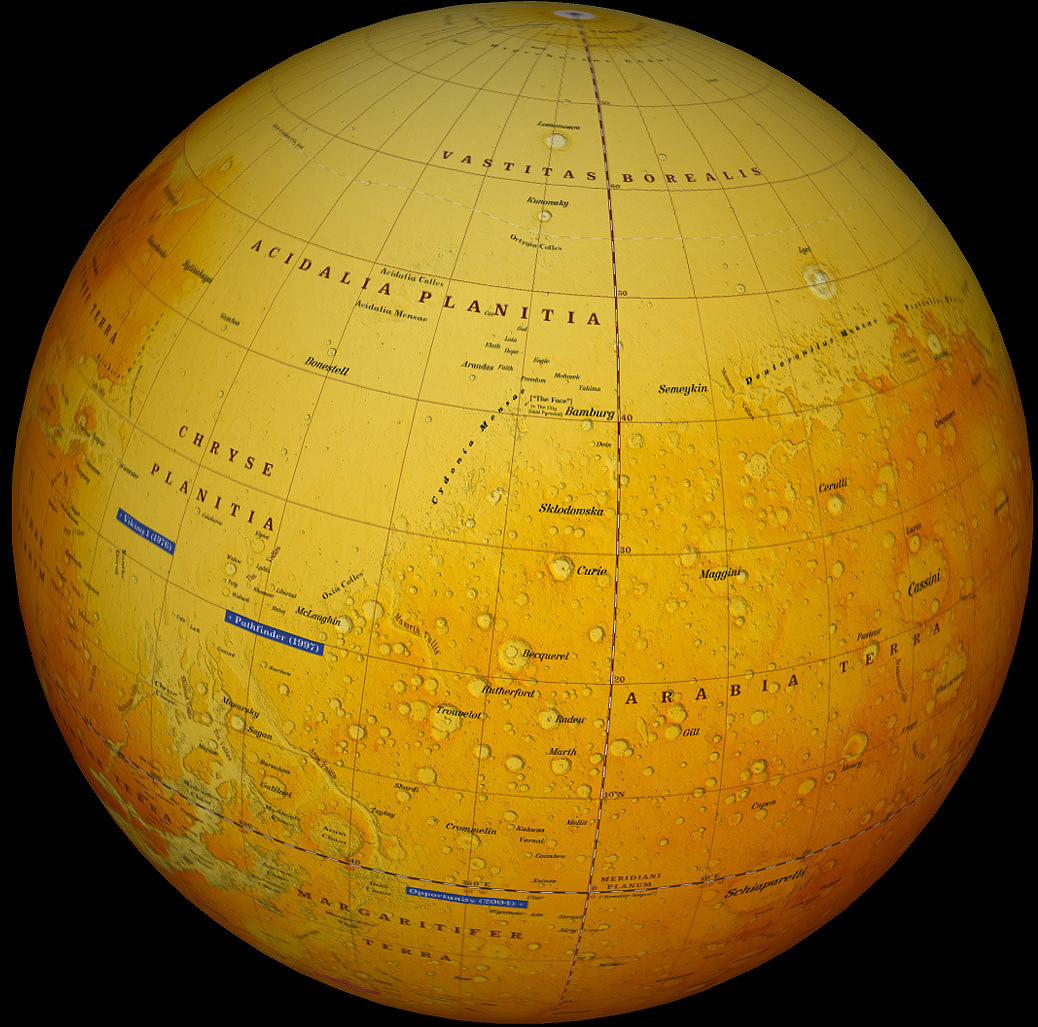Arabia Terra

| Origin of name: Country bordering on Aeria (Egypt). | A név eredete: északon Syria és Palaestina, nyugaton Aegyptus és az arab tengeröböl, délen az Erythraeum tenger, keleten a perzsa tengeröböl, északkeleten Babylonia és Mesopotamia a határa. Az aegyptusiak Punt-nak nevezték, a perzsák Arabájának. |
| Geologic description and interpretation: NW
Arabia Terra is primarily composed of
degraded, Noachian age cratered terrain that was formed during the era of heavy
bombardment, which ended ~3.7 Ga. It has several unique properties: Extremely
Degraded Surface, Lack of Valley Networks, Low Elevation, Thin Crust, Subdued
Terrain suggesting that large areas of it are partially buried. | Geológiai leírás és magyarázat: Az Arabia Terra ősi, lepusztult, noachi korú, sűrűn kráterezett felszínű, melynek felszíne még a nagy bombázás időszakában alakult ki 3,7 milliárd éve és azóta sem szenvedett nagyobb változásokat. Több egyedi vonása van: igen lepusztult felszíne, a völgyhálózatok hiánya, a déli felföldekhez képest alacsony magassága, alatta vékony kéreg, megsüllyedt felszín. Mindezek arra engedhetnének következtetni, hogy területének egy része eltemetett. Tehát az Arabia Terra nem egyértelműen a déli felföldekhez tartozik. Feltevések szerint egy óriási, többgyűrűs medence nyomát viseli, mely a Borealis-medence körül keletkezett. A medence akkor alakulhatott ki, amikor a kéreg még vékonyabb volt. Erre üledék rakódott, mely a noachiben vízzel került kölcsönhatásba, majd kiemelkedett a Tharsis-hátság hatására, ami a különféle rétegsorok differenciális erózióját eredményezte. |
      The "dichotomy boundary" on Mars is a linear feature without a name. Its transition zone inside Arabia Terra is referred to as "Highland-Midland Transition Zone (HMTZ)"            GEOLOGIC EVOLUTION OF THE MARTIAN HIGHLANDS: MTMS -20002, -20007, -25002 AND -25007. C. M. Fortezzo and K. K. Williams,vid A. Crown     CURRENT UNDERSTANDING AND FIRST YEAR MAPPING PLAN. J. A. Skinner, Jr., K. L. Tanaka, T. M. Hare., and D. B. Christensen. 2007 Abstracts of the Annual Meeting of Planetary Geologic Mappers, Tucson, AZ 2007 Open-File Report 2007–1233   GEOLOGY OF THE SOUTHERN UTOPIA PLANITIA HIGHLAND-LOWLAND BOUNDARY PLAIN: FIRST YEAR RESULTS AND SECOND YEAR PLAN. J. A. Skinner, Jr., K. L. Tanaka, and T. M. Hare, |